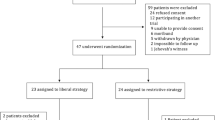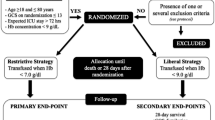Abstract
Purpose
To determine whether physician specialty influences transfusion threshold in patients with acute severe traumatic brain injury (TBI).
Methods
We surveyed transfusion preferences of chiefs of trauma surgery, chairs of neurosurgery, and surgical and neurosurgical ICU directors at all 187 US Level I trauma centers using a scenario-based, multiple-choice instrument administered by mail. We evaluated the hemoglobin value used as a transfusion threshold for patients with severe acute TBI in several scenarios as well as opinions regarding the rationale for transfusion.
Results
The response rate was 58% (312/534). Mean time in practice was 17 ± 8 years and 65% were board certified in critical care. Neurosurgeons (NS) used a greater mean hemoglobin threshold for transfusion of TBI patients than trauma surgeons (TS) and non-surgeon intensivists (CC) whether the intracranial pressure was normal (8.3 ± 1.2, 7.5 ± 1.0, and 7.5 ± 0.8 g/dL; NS, TS, and CC, respectively, P < 0.001) or elevated (8.9 ± 1.1, 8.0 ± 1.1, and 8.4 ± 1.1 g/dL; NS, TS, and CC, respectively, P < 0.001). All three groups commonly believed that secondary ischemic injury is an important problem following TBI (74, 66, and 63%, P = 0.32), but fewer NS believed that transfusions have important immunodulatory effects (25, 91, and 83%, P < 0.001).
Conclusions
Neurosurgeons prefer more liberal transfusion of TBI patients than TS and CC, suggesting that actual practice may depend largely on which specialist is primarily managing care. The observed clinical equipoise would justify a randomized trial of liberal versus restrictive transfusion strategies in patients with TBI.


Similar content being viewed by others
References
Kraus J, Chu L (2005) Epidemiology textbook of traumatic brain injury. American Psychiatric Publishing Inc., Washington, DC, pp 3–26
Langlois J, Rutland-Brown W, Thomas K (2004) Traumatic brain injury in the United States: emergency department visits, hospitalizations, and deaths. In: Traumatic brain injury in the United States: emergency department visits, hospitalizations, and deaths. Atlanta: Centers for Disease Control and Prevention, National Center for Injury Prevention and Control
Ariza M, Mataro M, Poca MA, Junque C, Garnacho A, Amoros S, Sahuquillo J (2004) Influence of extraneurological insults on ventricular enlargement and neuropsychological functioning after moderate and severe traumatic brain injury. J Neurotrauma 21:864–876
Sanchez-Olmedo JI, Flores-Cordero JM, Rincon-Ferrari MD, Perez-Ale M, Munoz-Sanchez MA, Dominguez-Roldan JM, Murillo-Cabezas F (2005) Brain death after severe traumatic brain injury: the role of systemic secondary brain insults. Transplant Proc 37:1990–1992
Malone DL, Hess JR, Fingerhut A (2006) Massive transfusion practices around the globe and a suggestion for a common massive transfusion protocol. J Trauma 60:S91–S96
Hebert PC, Wells G, Blajchman MA, Marshall J, Martin C, Pagliarello G, Tweeddale M, Schweitzer I, Yetisir E (1999) A multicenter, randomized, controlled clinical trial of transfusion requirements in critical care. Transfusion Requirements in Critical Care Investigators, Canadian Critical Care Trials Group. N Engl J Med 340:409–417
Lacroix J, Hebert PC, Hutchison JS, Hume HA, Tucci M, Ducruet T, Gauvin F, Collet JP, Toledano BJ, Robillard P, Joffe A, Biarent D, Meert K, Peters MJ (2007) Transfusion strategies for patients in pediatric intensive care units. N Engl J Med 356:1609–1619
Marion DW, Bouma GJ (1991) The use of stable xenon-enhanced computed tomographic studies of cerebral blood flow to define changes in cerebral carbon dioxide vasoresponsivity caused by a severe head injury. Neurosurgery 29:869–873
Marion DW, Darby J, Yonas H (1991) Acute regional cerebral blood flow changes caused by severe head injuries. J Neurosurg 74:407–414
McLaughlin MR, Marion DW (1996) Cerebral blood flow and vasoresponsivity within and around cerebral contusions. J Neurosurg 85:871–876
Raghavan M, Marik PE (2005) Anemia, allogenic blood transfusion, and immunomodulation in the critically ill. Chest 127:295–307
Mickey RM, Greenland S (1989) The impact of confounder selection criteria on effect estimation. Am J Epidemiol 129:125–137
Reasoner DK, Ryu KH, Hindman BJ, Cutkomp J, Smith T (1996) Marked hemodilution increases neurologic injury after focal cerebral ischemia in rabbits. Anesth Analg 82:61–67
Lee SH, Heros RC, Mullan JC, Korosue K (1994) Optimum degree of hemodilution for brain protection in a canine model of focal cerebral ischemia. J Neurosurg 80:469–475
Weiskopf RB, Kramer JH, Viele M, Neumann M, Feiner JR, Watson JJ, Hopf HW, Toy P (2000) Acute severe isovolemic anemia impairs cognitive function and memory in humans. Anesthesiology 92:1646–1652
Claridge JA, Sawyer RG, Schulman AM, McLemore EC, Young JS (2002) Blood transfusions correlate with infections in trauma patients in a dose-dependent manner. Am Surg 68:566–572
Offner PJ, Moore EE, Biffl WL, Johnson JL, Silliman CC (2002) Increased rate of infection associated with transfusion of old blood after severe injury. Arch Surg 137:711–716 (discussion 716–717)
Taylor RW, Manganaro L, O’Brien J, Trottier SJ, Parkar N, Veremakis C (2002) Impact of allogenic packed red blood cell transfusion on nosocomial infection rates in the critically ill patient. Crit Care Med 30:2249–2254
Tinmouth A, Fergusson D, Yee IC, Hebert PC (2006) Clinical consequences of red cell storage in the critically ill. Transfusion 46:2014–2027
Hebert PC, Fergusson DA, Stather D, McIntyre L, Martin C, Doucette S, Blajchman M, Graham ID (2005) Revisiting transfusion practices in critically ill patients. Crit Care Med 33:7–12 (discussion 232–232)
Winn HR (2004) Youmans Neurological Surgery, 5th edn. WB Saunders Company, Philadelphia
ACS Surgery Principles and Practice (2006) Web MD, New York
Carlson AP, Schermer CR, Lu SW (2006) Retrospective evaluation of anemia and transfusion in traumatic brain injury. J Trauma 61:567–571
McIntyre LA, Fergusson DA, Hutchison JS, Pagliarello G, Marshall JC, Yetisir E, Hare GM, Hebert PC (2006) Effect of a liberal versus restrictive transfusion strategy on mortality in patients with moderate to severe head injury. Neurocrit Care 5:4–9
Smith MJ, Stiefel MF, Magge S, Frangos S, Bloom S, Gracias V, Le Roux PD (2005) Packed red blood cell transfusion increases local cerebral oxygenation. Crit Care Med 33:1104–1108
Leal-Noval SR, Rincon-Ferrari MD, Marin-Niebla A, Cayuela A, Arellano-Orden V, Marin-Caballos A, Amaya-Villar R, Ferrandiz-Millon C, Murillo-Cabeza F (2006) Transfusion of erythrocyte concentrates produces a variable increment on cerebral oxygenation in patients with severe traumatic brain injury: a preliminary study. Intensive Care Med 32:1733–1740
Meixensberger J, Jaeger M, Vath A, Dings J, Kunze E, Roosen K (2003) Brain tissue oxygen guided treatment supplementing ICP/CPP therapy after traumatic brain injury. J Neurol Neurosurg Psychiatry 74:760–764
Fitzgerald RD, Martin CM, Dietz GE, Doig GS, Potter RF, Sibbald WJ (1997) Transfusing red blood cells stored in citrate phosphate dextrose adenine-1 for 28 days fails to improve tissue oxygenation in rats. Crit Care Med 25:726–732
Purdy FR, Tweeddale MG, Merrick PM (1997) Association of mortality with age of blood transfused in septic ICU patients. Can J Anaesth 44:1256–1261
Zallen G, Offner PJ, Moore EE, Blackwell J, Ciesla DJ, Gabriel J, Denny C, Silliman CC (1999) Age of transfused blood is an independent risk factor for postinjury multiple organ failure. Am J Surg 178:570–572
Leal-Noval SR, Munoz-Gomez M, Arellano-Orden V, Marin-Caballos A, Amaya-Villar R, Marin A, Puppo-Moreno A, Ferrandiz-Millon C, Flores-Cordero JM, Murillo-Cabezas F (2008) Impact of age of transfused blood on cerebral oxygenation in male patients with severe traumatic brain injury. Crit Care Med 36:1290–1296
Longhi L, Valeriani V, Rossi S, De Marchi M, Egidi M, Stocchetti N (2002) Effects of hyperoxia on brain tissue oxygen tension in cerebral focal lesions. Acta Neurochir Suppl 81:315–317
Nortje J, Coles JP, Timofeev I, Fryer TD, Aigbirhio FI, Smielewski P, Outtrim JG, Chatfield DA, Pickard JD, Hutchinson PJ, Gupta AK, Menon DK (2008) Effect of hyperoxia on regional oxygenation and metabolism after severe traumatic brain injury: preliminary findings. Crit Care Med 36:273–281
Peabody JW, Luck J, Glassman P, Dresselhaus TR, Lee M (2000) Comparison of vignettes, standardized patients, and chart abstraction: a prospective validation study of 3 methods for measuring quality. JAMA 283:1715–1722
Peabody JW, Luck J, Glassman P, Jain S, Hansen J, Spell M, Lee M (2004) Measuring the quality of physician practice by using clinical vignettes: a prospective validation study. Ann Intern Med 141:771–780
Author information
Authors and Affiliations
Corresponding author
Additional information
Felix D. Battistella: deceased.
This study was funded by the Department of Surgery, University of California, Davis Medical Center.
Electronic supplementary material
Below is the link to the electronic supplementary material.
Rights and permissions
About this article
Cite this article
Sena, M.J., Rivers, R.M., Muizelaar, J.P. et al. Transfusion practices for acute traumatic brain injury: a survey of physicians at US trauma centers. Intensive Care Med 35, 480–488 (2009). https://doi.org/10.1007/s00134-008-1289-z
Received:
Accepted:
Published:
Issue Date:
DOI: https://doi.org/10.1007/s00134-008-1289-z




